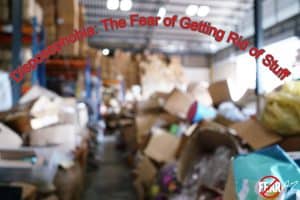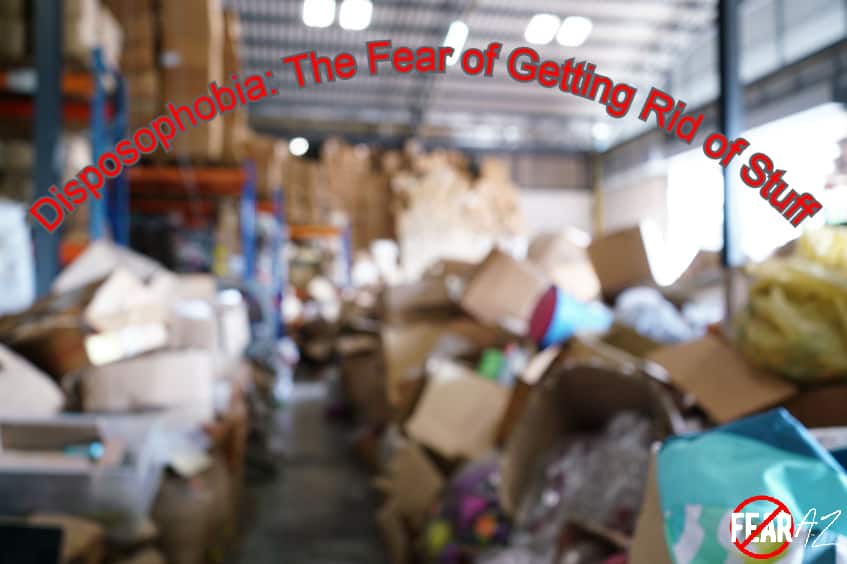Share This Article
Assistance with Getting Rid of Disposophobia, or the Fear of Throwing Things Away
Ever felt on edge when your family forced you to clean up in your childhood?
Does the task of discarding old possessions make you feel uneasy and restless?
Do you constantly have anxiety about getting rid of things, some of which have absolutely no use?
If the answer to all of these questions is yes and you constantly wonder Why can’t I throw stuff away?, you are most likely going through disposophobia.
Let’s work through in detail this irrational fear of throwing things away.
What Is Disposophobia?
Simply put, disposophobia is the irrational fear of getting rid of stuff. Why is getting rid of stuff so hard? Those with this condition experience inner conflict in throwing things away. They have a constant desire to accumulate things that have no apparent use or value.

The term itself is derived from the Latin word dispos, meaning “getting rid of personal belongings,” and the Greek term phobos, meaning “fear.” Together, disposophobia is the irrational fear of getting rid of possessions. It’s similar to a hoarding disorder.
In severe cases, those with disposophobia live in crowded homes piled high with things on tables, counters, floors, and windows. They may have no space to move around. This can quickly compound into further issues such as self-isolation and health risks.
The individual suffering from diposophobia will carry out compulsive hoarding. They experience acute anxiety when any of these items are moved or thrown away.
What is hoarding a sign of? Hoarding is a disorder on its own and can be a symptom of another condition. It’s closely linked to obsessive-compulsive personality disorder (OCPD), obsessive-compulsive disorder (OCD), attention-deficit/hyperactivity disorder (ADHD), and depression.
What Causes Disposophobia?
Similar to other specific phobias, diposophobia may be genetic or be related to one’s childhood or other environmental factors. Some probable causes include:
- Having a family member with this condition
- Injury in the brain that triggers you to hoard things
- Uncontrollable buying habits and inability to detach from things
- Traumatic life event
- Depression or obsessive-compulsive disorder
- The individuals have an intense sentimental value with the things around them. They feel they will lose those people connected to items or the significance of those items if discarded.
Disposophobia Symptoms
Disposophobia is associated with certain general, physical, and mental/emotional symptoms. The hoarding disorder affects an estimated 2 to 6 percent of the American population. Let’s take a closer look at possible symptoms.
General Symptoms
- Hoarding of unnecessary things
- Exhibiting indecisiveness, avoidance, procrastination, and lack of organization
- Difficulty in discarding or parting with things, and constantly saving hoarded items
- Cluttering rooms with food items and trash
- Not washing or discarding things
- Experiencing a feeling of comfort and security from the collected items
- Having a deep emotional connection with the items around you
Physical Symptoms
If an individual attempts to discard or is asked to do away with the collected things, they might experience severe anxiety. Here are some examples of how that anxiety may appear in an individual:
- Hot flashes or chills along with headaches and sweating
- Trembling or feeling shortness of breath
- Nausea, dizziness, or feeling of fainting
- Numbness, a dry mouth sensation, and constant confusion
- Hyperventilation over small things, and in extreme cases, fluctuations in blood pressure
Mental/Emotional Symptoms
A person suffering from disposophobia might undergo the following during a panic attack:
- A constant fear of losing or being ridiculed leading to social isolation
- Fear of losing control and thoughts of self-harm
- Constant state of hopelessness, lack of concentration
- Anger, irritation, and severe mood swings
- Fear of rejection
How to Get Rid of Stuff: Ideas for Disposophobia
- Start by locating a certified hoarding therapist. You must be able to trust those who wish to help you. You can also take a disposophobia test to know the intensity of your hoarding disorder. Involving a trained professional is a great way to better understand the phobia and work on controlling it.
- Try your best to understand the deep-rooted factors that have influenced your condition.
- The best plan of action can be undertaken when you come to terms with all the kinds of items hoarded. It’s important to understand the different forms of hoarding.
- Once you’ve gained enough resources, you can start cleaning and sanitizing your home.
- Work toward dividing your items into three categories to achieve a normal lifestyle. These are:
1. Keepsakes/collectibles
2. Donations
3. Trash/Garbage - Once the items are organized, start placing them back into the areas they fit. Throw away or donate those items that don’t fit. It’s important to remember that everything needs to be stored in its spot.
- Once you’ve completed the organization step, frequently clean your home to maintain a safe environment and prevent future hoarding.
Disposophobia Treatments
Cognitive Behavioral Therapy (CBT)
In CBT, you are guided to work on your thoughts to achieve positive behavior. It’s an efficient method, as desirable thoughts affect our entire body. The therapist supports discovering the reasons behind particular thoughts and behavior. It is short-term and can change the way a person feels. CBT dwells on making improvements in the present rather than focusing on the past.
Exposure Therapy
Exposure therapy is one of the most effective ways to treat a person with disposophobia. In this method, a therapist recommends ways to disrupt the pattern of avoidance of the fear. A safe environment is created where you are gradually exposed to your fears. This helps you reduce the avoidance and better deal with the triggers in reality. You will also be assisted with learning some relaxation techniques.
Neuro-Linguistic Programming
This therapy involves guiding the individual to:
- Experience the phobia in a safe space
- Dwell through the phobia along with happy emotions
- Gradually detach from the fears
Mindfulness-Based Stress Reduction (MBSR)
MBSR is generally an eight-week program that combines meditation and yoga. Started in the 1970s by Dr. Jon Kabat-Zinn, this method addresses all the negative thoughts, fears, feelings, and behavior. It develops awareness of the present moment and helps to reduce all the factors that contribute to stress and fears.
Tips to Avoid Disposophobia
While therapy and treatment for the phobia are encouraged, you can also adopt some healthy coping mechanisms that help you avoid the phobia.
- Meditation helps to clear the bundle of random fears and thoughts. It gives you a calmer approach to deal with the feared stimulus.
- Self-help groups are a gathering of people going through similar issues. These groups provide you moral support to deal with or avoid the fear. They also present the personal experiences of others and broaden your coping mechanisms.
- Take up jogging or follow an exercise routine. A healthy body will promote a healthy mind.
- Keep a check on your eating and drinking habits. This will help you reduce general anxiety.
- Adopt a healthy sleep cycle to improve concentration and focus.
In Conclusion
Phobias can be physically and mentally exhausting. While you have to deal with internal fears, you might also face stigma from the outside world.
If you have disposophobia or know of someone who is suffering with this phobia, remember that these fears are valid. They occur in people from all walks of life and deserve attention and treatment.
Treatment and adopting new behaviors have achieved milestones in reducing disposophobia and compulsive hoarding. It can curb the need to save items and allow one to live a hassle-free life.



